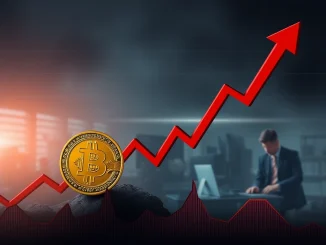
Navigating the volatile world of cryptocurrency trading requires more than just technical charts and market news. Understanding market sentiment is crucial, and the Crypto Fear & Greed Index serves as a powerful tool to gauge the prevailing emotions driving crypto markets. Recently, this insightful index has signaled a significant shift, moving from ‘Greed’ to ‘Neutral’. Let’s delve into what this means for you and the broader crypto landscape.
What is the Crypto Fear & Greed Index and Why Should You Care About Market Sentiment?
Imagine having a compass that points not to north, but to the emotional direction of the cryptocurrency market. That’s essentially what the Crypto Fear & Greed Index is. Created by Alternative.me, this index aggregates various data points to provide a single number reflecting the overall sentiment – from extreme fear to extreme greed – prevailing in the crypto market. Why is this important? Because market psychology plays a massive role in price movements, especially in the highly dynamic crypto space. Understanding whether the market is driven by fear or greed can offer valuable clues about potential market trends and turning points.
Think of it this way:
- Extreme Fear (0-24): Often indicates that investors are overly worried, potentially signaling a buying opportunity. Historically, periods of extreme fear can precede market bottoms.
- Fear (25-49): Suggests caution in the market. Investors are hesitant, and prices might be under pressure.
- Neutral (50): Represents a balanced market sentiment. Neither fear nor greed dominates, indicating a period of uncertainty or consolidation.
- Greed (51-74): Signals growing optimism and potential overvaluation. Investors are becoming more bullish, but caution might be warranted.
- Extreme Greed (75-100): Points to excessive optimism and potential market bubbles. Historically, extreme greed can precede market tops and corrections.
The Shift to Neutral: Crypto Fear & Greed Index at 49
As of February 22nd, the Crypto Fear & Greed Index stands at 49, a six-point drop from the previous day. This move signifies a shift from the ‘Greed’ zone into ‘Neutral’ territory. This cooling of sentiment suggests that the bullish enthusiasm that may have been present has waned, and the market is entering a phase of indecision or reassessment. This doesn’t necessarily mean a downturn is imminent, but it does warrant a closer look at the underlying factors influencing this change in market sentiment.
Decoding the Factors: What Drives the Fear & Greed Index?
The Crypto Fear & Greed Index isn’t based on guesswork. It’s a data-driven metric that combines several key indicators to provide a comprehensive view of market emotions. Let’s break down the six factors that contribute to the index:
| Factor | Weight | Description | Impact on Sentiment |
|---|---|---|---|
| Volatility (25%) | 25% | Measures the current and maximum drawdowns of Bitcoin, comparing it with the corresponding average values of the last 30 and 90 days. | High volatility often fuels fear and uncertainty. |
| Market Momentum/Volume (25%) | 25% | Compares current market momentum and volume with the last 30 and 90-day averages. | Strong momentum and high volume generally indicate greed and bullishness. |
| Social Media (15%) | 15% | Analyzes social media sentiment, particularly on platforms like Twitter, using hashtag counts and engagement metrics. | Positive social media buzz can reflect and amplify greed, while negative sentiment can fuel fear. |
| Surveys (15%) | 15% | Periodically conducts crypto market surveys to gauge investor sentiment directly. (Currently paused) | Survey results provide direct insights into investor feelings of fear or greed. |
| Bitcoin Dominance (10%) | 10% | Measures Bitcoin’s dominance relative to the broader crypto market. | Rising Bitcoin dominance can sometimes indicate a ‘flight to safety’ during fearful periods. |
| Google Trends (10%) | 10% | Analyzes Google Trends data for Bitcoin-related search queries. | Increased search interest in Bitcoin can reflect both curiosity and potential FOMO (Fear Of Missing Out) during greedy phases. |
What Does a ‘Neutral’ Crypto Fear & Greed Index Mean for Your Crypto Strategy?
The shift to a ‘Neutral’ reading in the Crypto Fear & Greed Index presents a moment for strategic reflection rather than immediate panic or euphoria. Here are some actionable insights to consider:
- Assess Your Portfolio: Review your current crypto holdings. Are you overexposed in certain areas? A neutral market can be a good time to rebalance and diversify your portfolio.
- Do Your Own Research (DYOR): Don’t rely solely on the Fear & Greed Index. Dive deeper into individual crypto projects, analyze their fundamentals, and understand their potential for long-term growth.
- Consider Dollar-Cost Averaging (DCA): In a neutral market, volatility can still persist. DCA, a strategy of investing a fixed amount at regular intervals, can help mitigate risk and average out your entry price.
- Stay Informed: Keep a close watch on market news, regulatory developments, and technological advancements in the crypto space. These factors can significantly influence crypto sentiment and future market direction.
- Manage Your Risk: Neutral markets can be unpredictable. Ensure you have proper risk management strategies in place, including setting stop-loss orders and only investing what you can afford to lose.
The Power of Understanding Crypto Sentiment
The Crypto Fear & Greed Index is more than just a number; it’s a window into the collective psyche of the cryptocurrency market. By understanding how fear and greed influence market dynamics, you can make more informed decisions, avoid emotional trading pitfalls, and potentially capitalize on market opportunities. While the index currently sits in ‘Neutral’, remember that market sentiment is fluid and can change rapidly. Staying vigilant, informed, and adaptable is key to navigating the ever-evolving world of crypto investments. The current neutral zone offers a valuable pause for traders and investors to reassess, strategize, and prepare for the next shift in market emotions.



